Last updated: Oct 8, 2021
tl;dr
Use a Polar H10 sensor for most accurate heart rate tracking. It works with your phone. Consider using it with the EliteHRV app to get recovery insights. To upgrade, splurge on adding a smart watch (cheap or expensive) to get more recovery insghts.
Exercise gets more useful (not to mention more interesting) when you turn it into a science experiment.
The easiest way to do that is to get a heart rate monitor.
But there are a ton of heart rate monitors out there. And even if you have one… what are you supposed to do with it?
The process of finding and using a heart rate monitor can be complex, but it’s easier when you break it down step-by-step.
Today we’re going to talk about
- Why you would want to use a heart rate monitor
- Different types of heart rate monitors
- How to use it to measure your body and tweak your training
Why Would You Want to Use a Heart Rate Monitor
A heart rate monitor tells you how fast your heart is beating and is one of the easiest training tools for anyone to use. Using a heart rate monitor, you can…
- Train the specific body qualities that you want
- See how well you are recovering from an exercise
- See how well you are recovering between workouts
- See how efficiently your heart works
From all of this information, you can modify your training on the fly and plan it out with much more focus than you’d otherwise be able to.
Training specific body qualities
Heart health can be measured in many different ways. You’ll want a heart that’s free of disease, has valves that work, and cardiac muscle tissue that is alive. But heart health doesn’t help much if the rest of the body isn’t doing well, so it’s more important to look at the health of your heart AND your blood vessels (i.e. veins, arteries, and capillaries). We call this cardiovascular fitness.
What makes a healthy heart? Well, when looking at training the heart, we normally presume that it is free of major defects. That’s why you should always ask your doctor if exercise is safe for you. Once you’ve done that, it’s about efficiency: is your heart overworking or not? This is where your heart rate monitor becomes really useful.
Unhealthy hearts can only pump a little bit of blood, so they have to pump really fast to get enough blood out to the rest of the body. Healthy hearts take in a lot of blood, then have a lot more downtime between beats to rest up. If your heart rate monitor tells you that you’re heart is beating more than 70 times a minute immediately after waking up, then your heart is probably not too healthy.
What makes for healthy blood vessels? After blood leaves the heart, it’s carried to the rest of the body by little pipes we call blood vessels. But these vessels are so much more complex than the generic water pipes in your house because they can change their shape. Sometimes you want your blood pressure to increase so that you can get blood all the way throughout your body, so the blood vessels get skinnier, helping push the blood through. Then they relax when you relax, opening up the vessels and decreasing your blood pressure.
When someone has unhealthy blood vessels (that is, poor cardiovascular fitness), they suck at changing the size of their pipes. These pipes get all clogged up and have a hard time relaxing when you’re trying to chill out. This is known as hypertension.
The heart and blood vessels work together very closely. If the pipes are clogged and can’t relax, then the heart has to work harder to get blood to the rest of the body. And if the heart is pumping harder, the blood vessels get damaged more easily, clogging them up even more. It’s a vicious cycle.
So when we measure cardiovascular fitness, we are concerned about addressing both the heart AND the blood vessels. A heart rate monitor can tell you which of these need more training (with some tests we’ll talk about later) and how to train them (with some training methods we’ll talk about later).
See how well you are recovering from an exercise
You need energy to do an activity, and your body produces energy in three different ways. Some of these ways produce chemicals that are toxic to your body when they build up in your system for a really long time (don’t worry, they’re removed quickly).
This is why your heart still beats hard when you’re resting after an exercise; it has to help clear out the byproducts of hard work. If your cardiovascular fitness is high, then you’ll be able to recover from exercise much faster.
Let’s do a thought experiment together.
- Strap a heart rate monitor on a fit person and an unfit person.
- Have them both jump up and down for a minute. They will both become exhausted.
- Look at their heart rates. They will be pretty similar assuming they are around the same age.
- NOW HERE’S THE COOL PART: watch what happens to their heart rates as the next few minutes pass.
- The fit person’s heart rate will come back down pretty quickly.
- The unfit person’s heart rate will stay elevated for minutes.
Why? That minute of jumping left all this crap in our two subjects’ bodies that they need to clear out. Our fit friend is able to pump a lot of blood and deliver it to the muscles so that they can clear out this crap. But our unfit friend doesn’t pump much blood EVEN THOUGH his heart beats just as often as our fit friend (actually, over time it beats more often). It takes longer to clear out all the gunk.
You can use this idea to see how well you are recovering from an exercise and when your heart is ready for more.
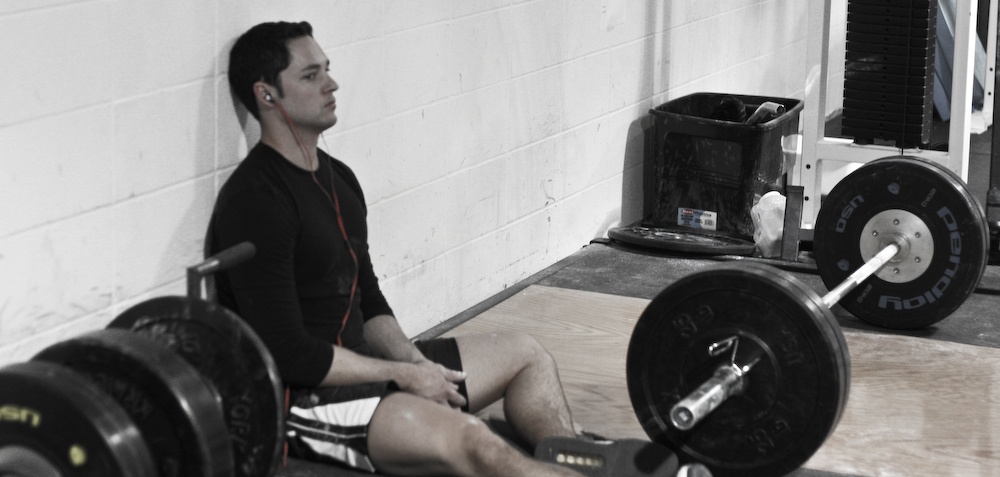
See how efficiently your heart beats
Remember all that talk about about cardiovascular fitness? If you measure your resting heart rate every morning, you can get an idea of how efficiently your heart beats (more on this soon).
See how well you are recovering between workouts
If you measure your resting heart rate every morning, you will notice that it’s not the same every morning, even if you’ve slept for the same amount of time each night.
Just like your heart helps you recover from an exercise, it also helps you recover from a day of doing stuff. This can be used to measure of your stress levels. An even better method is to get an app that will track your heart rate over minutes, then compute the differences in time between beats. This is known as heart rate variability (HRV) and is an even better measure of your stress levels.
NOTE: It is my understanding that some watches do this, but Polar’s marketing department does not make it very clear which models will give you this information. You’re probably best using the app and a Bluetooth Smart heart rate monitor strap (e.g. Polar H10).
This method isn’t foolproof, but it can still give you good insights (more on this soon).
Different Types of Heart Rate Monitors
There are many different ways to measure your heart rate.
- Strap with watch
- Bluetooth strap
- Phone sensor
- Fitness watches
- Your fingers!
Strap with Watch
This is what most people picture when they think of a heart rate monitor. It is three pieces:
- A strap that goes around your chest
- A sensor that connects to the strap to pick up electrical activity from your heart
- A watch to take in all of the data and tell you what it means
Cost increases as the watch does more cool stuff. Basic models essentially just tell you your heart rate, while the more expensive models will take that data and tell you things like HRV, the time spent in specific training heart rate zones, and even how fast you’re traveling.
Advantages
- Compatible with most cardio equipment heart rate monitors, allowing your heart rate to be displayed on the machine while you’re working out
- Gives continuous measurements, allowing you to use it to determine the length of your rest periods
- Permitting the technology is working, the strap stays out of your way so you can focus on your workout
- Higher end models allow for also measuring things like speed, aerobic training intensity, and heart rate variability
- Lots of different model options
Disadvantages
- Both the watch and the sensor run on those disc-like batteries that you usually see in watches, which, in my opinion, are a pain
- This type of sensor is not compatible with a phone, so it won’t work with apps
Ultimately, this is a good option if you want a heart rate monitor separate from your phone. Polar is one of the leading producers of heart rate monitors.
Their Unite model is an example of the basic sensor strap with watch. This will measure your heart rate and give you advice on your workouts, sleep, and recovery.
If you want to splurge, the Polar Vantage V2 is the premium model. This is more of a “smart watch” and will give you music controls, plus weather and phone notifications.
Both of these models are designed to work without a heart rate monitor strap, collecting the heart rate at the wrist. I haven’t tried these specific models, but I’m wary of the accuracy of the heart rate measurements during exercise. If anyone can speak to the efficacy, please leave a comment below.
Having said that, however, it is my understanding that both of these models will still work with a Bluetooth sensor like the H10, which would be useful if you want more accurate readings. More on those below.
Some of these Polar products will also allow you to download all of your data, if you’re into hacking.
Bluetooth Smart sensor strap with phone
The Bluetooth Smart sensor is similar to the one mentioned above, except it is compatible with more technology. These sensors, in addition to working with most watches, can also send data directly to some computer like your phone.
Advantages
- The Bluetooth Smart sensor is compatible with all smartphones these days, allowing you to use an app to track your heart rate over your workout
- Compatible with most cardio equipment heart rate monitors, allowing your heart rate to be displayed on the machine while you’re working out
- Gives continuous measurements, allowing you to use it to determine the length of your rest periods
- Permitting the technology is working, the strap stays out of your way so you can focus on your workout
- Some apps allow for also measuring things like speed, aerobic training intensity, and heart rate variability
- Lots of different app options
- No watch necessary
- Maximum accuracy
Disadvantages
- Requires that Bluetooth be enabled on your phone, sucking battery life
- Bluetooth range is limited and can short out if too many things are blocking the signal
Ultimately, this is a good option if you have a smartphone and are comfortable bringing it along for a workout. I use the Polar H10 paired with my phone. The interface to record the workouts is the Polar Beat app.
Phone sensor
If your phone has a flash right next to the camera, you can even use a phone app alone to measure your heart rate.
Since you’ll usually have your phone with you, this is really convenient for getting a heart rate reading throughout the day. This method gets a little shotty when you start trying to use it during exercise.
Samsung (if you’re into that Android thing) has the S Health app, which you can use to track all sorts of things:
- Heart rate
- Heart rate variability (deemed the “stress” feature)
- Steps
- Caffeine intake
- Bodyweight
- Food intake
- Water intake
- Sleep quantity
- Blood glucose
- Blood pressure
- Exercise
There are even other partner apps that you can add to increase functionality. Samsung has actually put together a pretty cool central hub for tracking not only your heart rate, but your general health markers of choice.
Let’s pretend you’re hypertensive and pre-diabetic. If you want to start taking control of your health, you can enter your daily resting heart rate, blood pressure, and blood glucose measures and evaluate them every two weeks to see if you’re making progress. If you’re not, you know to step it up, but if you are, then you get a nice reward knowing that all the hard work you’ve been putting in is finally paying off.
If you don’t want all the S Health app stuff, there’s another app that will speedily measure your heart rate called Instant Heart Rate (available on Android and Apple).
Ultimately, the this is a good option for day-to-day lifestyle changes and measurements, but if you just want to track your heart rate for exercise purposes, they can distract your from your workout because they don’t provide continuous readings. Look into a dedicated strap with sensor instead (e.g. above).
Fitness trackers
Similar to the S Health app, fitness trackers can do more than just measure your heart rate.
This tech has evolved over the last few years, and as a result, the difference in competition has diminished. If you’re looking for a fitness tracker, I would look into Fitbit or Garmin. If you are deep in the Apple ecosystem, an Apple Watch might be what you want.
Beware, though, that I’ve noticed inconsistency in the measured heart rates during exercise. These seem to be less accurate than a dedicated sensor separate of watch.
Advantages
- Does more than just heart rate
- Stays locked on your wrist, making it harder to lose
Disadvantages
- Must be worn on wrist
- Can cost a pretty penny for even basic heart rate functionality
- Less accurate during exercise
Ultimately, this is a good option if you want to fit in. Due to their popularity, you’ll probably be able to initiate a discussion or two with the cute barista about your Fitbit, then theoretically take her/him out on a date, fall in love, get married, have children, resent each other, stay together until the kids move out, find love again in Paris (with a new person), finally get divorced, then retire from your career to lead a new love life and open a coffee shop in Florence.
The Whoop band seems to be the most well-designed, overall beautiful product. My judgement has told me that the Oura ring is probably better for sleep data, but if you want only one device, the Whoop band will give you better exercise data.
The Fitbit Inspire line is currently the most affordable option and claims to measure heart rate.
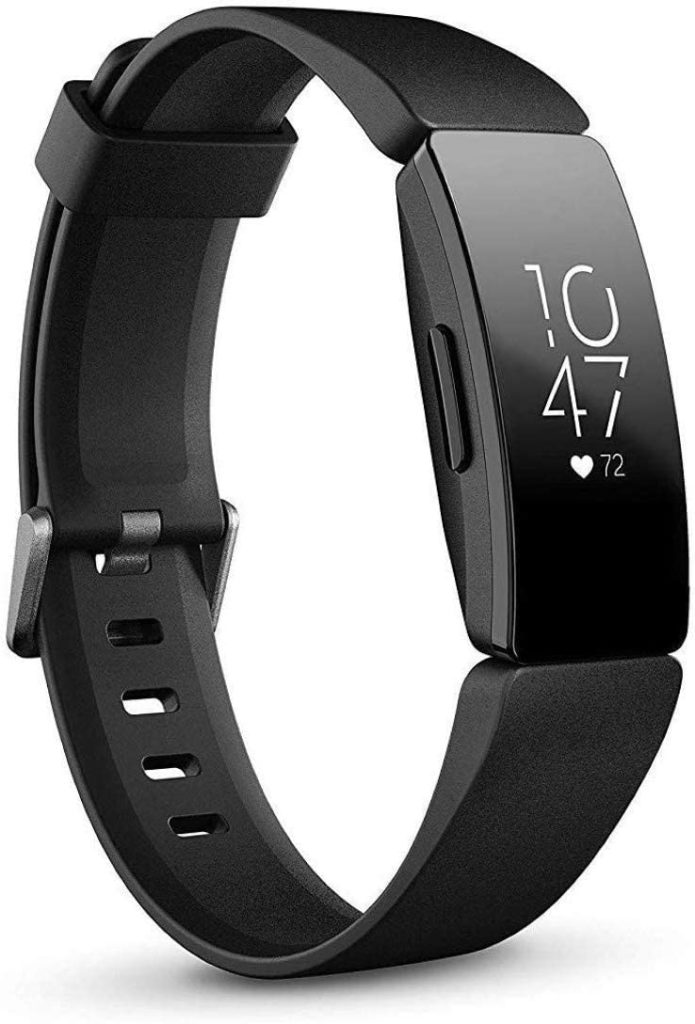
Your fingers
This is hands down (pun unintentional) the cheapest method for measuring your heart rate.
Measuring your heart rate with your hands is usually done on the wrist or on the neck, but if you know your anatomy, you can try other spots, too. Heart rate is most often measured in beats per minute, so you can count however is most appropriate for your exercise.
- # of beats in 60 seconds
- Good for patient individuals taking resting measurements
- (# of beats in 30 seconds) x 2
- Good for taking resting measurements
- (# of beats in 15 seconds) x 4
- Good for taking resting measurements when on the go
- Good for measurements during a workout, especially when rest period is a minute or longer
- (# of beats in 6 seconds) x 10
- Good for measurements during a workout, especially when rest periods are short or non-existent
- Ex: When doing cardiac output development (more on this soon)
Advantages
- Cheap
- Portable
- Kind of meditative because it makes you sit still and pay attention to what your body is doing
- Really cool for feeling how your heart rate changes with inhale and exhale (POP QUIZ: Does the exhale make it speed up or slow down?)
Disadvantages
- Requires a stopwatch or clock
- Requires palpation skills (this is harder on some people than others)
- Requires math skills (hope you practiced in high school)
- Difficult to take while still working out
Ultimately, using your fingers is good for when you just want a general idea of your heart rate, but don’t have any equipment or technology available to do it for you.
PRO TIP: If you’re in the market for a new heart rate monitor, check with the company before you buy to make sure they will be compatible with your phone and perform the tasks you want. Here is a list of the best selling heart rate monitors on Amazon.
Now that you’ve got a heart rate monitor picked out, let’s talk about how you’re going to use it.
Measuring Your Fitness With a Heart Rate Monitor
There are tons of things you can measure with your heart rate monitor, but here are the most helpful things that I suggest you worry about:
- Resting heart rate
- Peak energy output
- Heart rate recovery
- Anaerobic threshold
- Response to exercise
Resting heart rate
Your resting heart rate (RHR) is a measurement of the how fast your heart is beating when your body is under minimal stress. This is a good measure of how efficiently your heart beats. A low RHR indicates that you can pump more blood with one beat.
It is suggested that average ranges from 60-100 beats per minute (bpm), but well-trained athletes are usually between 40-60 bpm (American Heart Association, accessed 17 Jul 2015). I want most of my clients below 60 bpm, but if you’re above 70 bpm, then the main thing you need to focus on improving is your RHR, which you can do with the Cardiac Output Development technique (more on that later).
Instructions
- Measure your heart rate first thing in the morning while still laying down
- Do this every day for two weeks
- Average the values. Consider this average your baseline RHR
Heart Rate Variability
The same thing you do with RHR can be done with Heart Rate Variability (HRV), which may be a better indicator of things like your response to stress.
To figure out HRV, the application just needs to compute the time between each heart beat, then do some statistical math. If the time between beats is relatively constant, then you have low HRV, but if that time is all over the place, you have high HRV. For more science on HRV, check out this post.
To measure HRV, follow the instructions given to you by the application you’re using (here’s a suggestion).
Here’s an example screenshot from the Elite HRV app.

Peak energy output
There’s a test called the One Minute Go Test that measures your ability to produce energy. You’re going to measure how far you go and how your heart responds. Usually I just make people run back and forth down the length of our turf (~70 feet).
Set up your heart rate monitor beforehand because you’ll want to start measuring as soon as the activity is over.
This One Minute Go Test measures the ability of all three of your energy systems to turn on and work as fast as they can, but you can also use this to test your heart rate recovery.
Heart rate recovery
You want to be able to produce as much energy as possible, but you also want to be able to shut down as quickly as possible once you no longer have to work hard. This is a good indicator of work capacity and the speed at which your aerobic energy system can turn on. The aerobic system produces more overall energy, but it is slower to work initially. Warming up helps turn this energy-producing system on so that you don’t fatigue as quickly during an event.
One Minute Go Test with Heart Rate Recovery Instructions
- Set up your heart rate monitor and make sure it’s working
- Warm up
- Pick an activity you’re good at (e.g. running, cycling, skating)
- Record your pre-test heart rate
- Do as much of the activity as you can in one minute
- Record your heart rate as soon as you’re done
- Record how far you travelled while you recover
- You can retest later on to see if your energy output improved
- Monitor your heart rate until reaches 130 bpm or lower
- It’s nice to have a heart rate monitor that will save all of the heart rate data it records, but if you don’t have this feature, record every 30 seconds until you reach 130 bpm
The goal for most people is to recover to under 130 bpm in one minute or less. Only very well-conditioned athletes can do this because they have very strong aerobic systems.
Here’s a graph to illustrate the difference between a well-conditioned individual and a poorly conditioned individual.
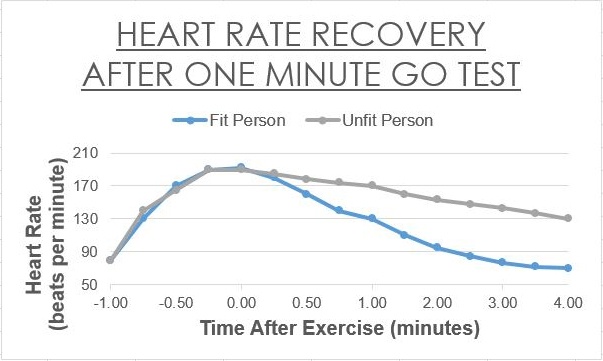
If you’re not able to get under 130 bpm in one minute or less, you’ll want to do some sort of training method when you work really hard, then rest really hard. An example of this would be repeated sprints (more on those later).
Anaerobic threshold
The anaerobic threshold (AT) is the point where your primary means of developing energy switches from aerobic (with oxygen) to anaerobic (without oxygen). This threshold is usually designated with a specific heart rate and once you cross it, fatigue accumulates much quicker.
To illustrate AT, picture a mixed martial artist. These athletes generally fight around this threshold most of the fight. Those who stay above it for too long are the ones who gas out, appearing to get extremely tired at the flip of a switch. If you can fight off fatigue, it means you have a strong aerobic system.
Anaerobic threshold training is high-intensity aerobic training meant to push your threshold higher. It teaches you to maintain a high intensity without fatiguing and can be considered a form of endurance.
To measure AT, I suggest using a Modified Cooper Test. There are other ways to measure anaerobic threshold, but this method is the cheapest and easiest to set up.
- Set up your heart rate monitor
- Warm up
- Pick an activity that you’re good at and can go on continuously (e.g. running, cycling, skating)
- Start performing your chosen activity, gradually warming up to higher intensity (if you just did the One Minute Go Test, this shouldn’t take long)
- When ready, start a timer
- Go as far as you can in 6 minutes
- Record your heart rate throughout the test and find the average during those 6 minutes
- If you need to, just record what your heart rate is at every minute interval and average those six numbers when you’re done
This average is an approximation of your anaerobic threshold. You can use this number to do some Threshold Training Intervals to train high-intensity aerobics (more on this later).
Response to exercise
This method is similar to measuring your heart rate recovery after a One Minute Go Test. Here are some questions you can answer with some simple heart rate monitoring:
- How well am I recovering between sets?
- How well am I recovering between exercises?
- When should I stop doing this exercise?
- When should I end my rest period?
Tracking your heart rate for minutes after an activity can shed light on how stressed you are and how stressful that activity was.
For example, if I do 5 sets of 5 reps of front squats at a Rating of Perceived Exertion (RPE) of 8, I can track what my heart rate is at the beginning of each set. If I notice it’s higher than it usually is at set 3, maybe I don’t want to do all 5 sets today. Or maybe I don’t want to keep increasing the weight. Alternatively, maybe I’ll do an extra set because my heart rate didn’t show any accumulation of fatigue until the 5th set.
But what about this: MAYBE I DON’T EVEN WANT FATIGUE. For example, when I’m trying to build my power-endurance work capacity. Say I’m doing three reps on the bench every 60 seconds until I start to slow down. Monitoring your heart rate throughout this can give you a more objective view of your training state.
A final scenario: when an athlete comes in and their heart rate doesn’t recover to 130 bpm after a One Minute Go Test until 7 minutes later (yes, I’ve had this before), then there are two things I want to do with them:
- They need tons of Cardiac Output Development
- I want to use their heart rate to tell them when they should stop resting if they have to do high-intensity conditioning drills like sprint repeats
Now, if they can’t fight off fatigue, sprint repeats are probably not the safest option for them. But we live in a world that is anything but ideal, meaning this athlete probably has 8 weeks with me until practice starts and they can’t make it in anymore. They will need to sprint at practice because their coach was never trained in human physiology. In this case, yes, I will give him some repeat sprints. I will teach him about fatigue, recovery, and energy systems to illustrate the importance of doing things correctly. I will tell him to look at his heart rate monitor and rest until his heart rate comes back down (more on this later).
Hopefully all of these ideas have given you a good idea on how you can use your heart rate monitor to guide your training. Now let’s talk about how to actually train with it.
Training With Your Heart Rate Monitor
Once you’ve measured what you want to measure, it’s time to train what you need to train.
Resting Heart Rate Fluctuation
In addition to giving you an idea of your heart’s efficiency, your resting heart rate also gives you an idea of how fresh your body is. You do this by comparing your daily RHR to your baseline/average RHR. If there’s a big difference (i.e. more than 6 bpm), you should switch up your training for the day.
If your RHR is higher than normal, then you may want to exercise a little easier today. For example, if your baseline is 52 bpm, but you wake up and measure 61 bpm, this is an indicator that your body is trying to help you recover from the stress you’ve recently put on it.
- If you were planning to do some resistance training, you should cut the sets you do in half and shorten your rest periods. Use less weight if necessary as well. The goal is to get a sweat on. Alternatively, you can do some Cardiac Output Development (more on this soon).
- If you were planning on doing some cardiovascular training, just make sure it isn’t anything too intense. Your heart is already under stress, so adding more is probably not the best thing for it at this point. Again, Cardiac Output Development is a good mode of active recovery in this situation.
- If you were planning on not working out, go for a brisk walk that’s just intense enough to get a little bit of sweat.
If your RHR is lower than normal, then you may want to exercise a little harder today. For example, if your baseline is 52 bpm, but you wake up and measure 42 bpm, go into the gym and kill it.
- If you were planning to do some resistance training, use a little more weight and maybe add another set to your main exercise. Only do this is you also feel good and are excited to train.
- If you were planning on doing some cardiovascular training, you may be able to tolerate a longer duration or higher heart rates. Add 10 minutes or try to go further in the same time period. Maybe scrap what you were going to do and try some Threshold Training (more on that soon).
- If you weren’t planning on working out, maybe go do something exciting or recreationally active. Cliff jumping, sky diving, golfing, go karts… something your danger levels can tolerate.
If there isn’t any major difference, just do whatever you had planned for the day. For example, if your baseline is 52 bpm and you wake up and measure 50 bpm, do whatever you had planned for the day.
Heart Rate Variability Fluctuation
Heart rate variability generally has a similar response to resting heart rate, but the relationship to health is flipped.
- If HRV is high, you should train harder.
- If HRV is low, you should take it easier.
- If HRV is normal, keep things as normal.
The Elite HRV app I mentioned before encourages you to do Morning Readiness readings and gives you a score on how ready you are to train that day.
Cardiac Output Development
This method is by far the most versatile for people because it has one very simple requirement: keep your heart rate between 120-150 bpm. If you’re less in shape, err on the side of 120 bpm. If you’re more in shape, err on the side of 150 bpm. The goal here is usually to lower your resting heart rate over weeks, months, or years, but this method can also be used as an active recovery day to help speed along your rest and regeneration.
The heart rate range is so specific because it’s trying to teach your heart to pump as much blood as possible with each beat. If you get above 150 bpm, there isn’t enough time for enough blood to get into the heart. If you are below 120 bpm, there isn’t enough demand for blood to fill the heart. When the heart practicing pumping as much blood as possible with each beat, it learns how to become more efficient. Then the resting heart rate lowers.
Most people try to build a healthy heart by just going out for a run because they think it’s good for them. The problem that I see time and time again with new people who come in to see me is that they start running before their bodies are ready to support the demands of running.
Too many people run to get in shape instead of getting in shape to run.
There are three main ways I’ll program cardiac output development.
- One long, slow, repetitive exercise
- A circuit of exercises with rest as needed
- A game of some sort
The first is simple: run, bike, swim… whatever you want to do that allows your heart rate to stay between 120-150 bpm. This option is good for people who:
- Are physically able to do these things
- Really enjoy doing these things
- Are good at putting up with monotony
The second option is my favorite to program for my clients. This allows me to pick exercises that I know are helpful and appropriate so that I can clean up their movement while also training their heart. This option is good for people who:
- Can safely perform a few exercises
- Get bored easily
- Need to clean up their movement patterns
Here’s an example circuit workout that I stole from a popular post of mine.
- 2-KB Front Squat
- Push Up
- Reverse Lunge (alternate legs)
- Split Stance Cable Row (left arm)
- Split Stance Cable Row (right arm)
- Dead Bug
Do exercise 1 for 45 seconds, then rest for 15 seconds. Do exercise 2 for 45 seconds, then rest for 15 seconds again. Go through all five exercises 6 times for a total of 30 rounds. The goal is to keep moving, so keep the weights light. If your heart rate is too low, move faster. If your heart rate is too high, lower the weights.
The third option is my favorite to do. This way I can get out of my head a little bit and do something fun. Some of my favorite games to play are handball, wall soccer, and soccer tennis.
Honestly, all you need is a little creativity. Figure out something you can do and will enjoy. The only thing you have to pay attention to is your heart rate monitor.
Anaerobic Threshold Training
Threshold training is a little more difficult than traditional cardiac output development. To do threshold training, you want to do an activity at about the average heart rate you found from the six minute Modified Cooper Test.
This is an approximation of your anaerobic threshold which, as we discussed earlier, is the point where your activity turns from aerobic & manageable to anaerobic & unsustainable (that is, your lungs feel hot like an erupting volcano).
You need an activity that you can perform well enough to sustain high heart rates. Traditionally, running works well.
Main points of threshold training:
- Do any exercise you can do continuously with a high enough heart rate
- Good movements to use: running, cycling, kettlebell swings/snatches, something you perform well
- Bad movements to use: jumping, Olympic lifts, anything you perform poorly
- Stay around your anaerobic threshold heart rate (+/- 5 bpm) for 1-10 minutes
- Rest for 1-5 minutes
- Repeat 2-5 total times (as long as you’re able to maintain speed)
NOTE: These values can be changed based on what you need to train. Choose the numbers that you can perform safely.
Repeated Sprints
Repeated sprints are great for team sport athletes and are, in my opinion, highly underutilized in the training world.
Take football for example. They run really hard for a really short period of time, then they rest for a longer time. So they need the ability to go really hard and to REST really hard.
For our general workout warriors just looking to be in shape, these repeat sprints are great for shortening your heart rate recovery time that you found after the One Minute Go Test. Repeated sprints are a great way to develop cardiovascular fitness.
When you do interval training, it’s divided into a “work” period and a “rest” period. The work period is when you’re actually doing the exercise. The rest period is when you’re catching your breath. Repeated sprints are a little counterintuitive because you’re actually training your aerobic fitness while you’re RESTING. I know, it’s crazy. Actually, it’s just science.
Your heart rate monitor is great for intervals like this.
- Choose an exercise you’re good at
- Good movements to use: running, biking, sled sprints, jumping, anything pretty intense that you enjoy
- Bad movements to use: biceps curls, dumbbell flyes, anything that can’t get your heart rate elevated high enough
- Try really really hard for 8-15 seconds (more isn’t always better)
- Rest until your heart rate monitor says your heart rate is below 140 bpm
- Repeat 8-20 times
Summary
So we’ve gone over a few things today…
- Why you would want to use a heart rate monitor (cardiovascular fitness!)
- Which heart rate monitor to get (do you want to use a cheap watch, an expensive watch, a phone, or your fingers?)
- What to measure with your heart rate monitor (with a few tests for you to use)
- What to train with your heart rate monitor (with a few new exercises for you to try)
Now go give your new heart rate monitor a test drive! Do you have other cool uses? Throw them down in the comments section below.
If you found this useful, it would be great if you sent it to someone else who might also find it useful.
Other articles you might like:
- Stop Stretching, You’re Wasting Your Time – Here’s What to do Instead
- Unlocking the Secrets of Willpower: How Exercise Helps You Stop Eating Dessert
- Keep The Weight Off Forever
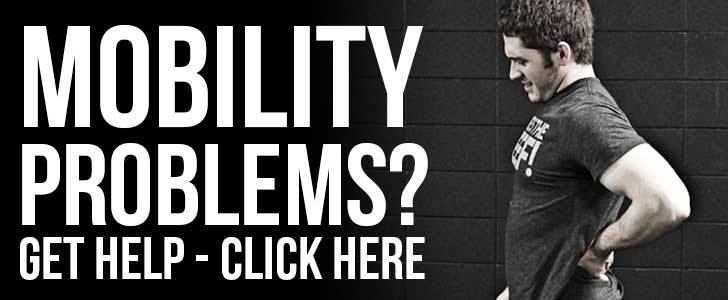
Photo credits: Bryan Brandenburg (CC BY-SA 3.0); Allen Tucker
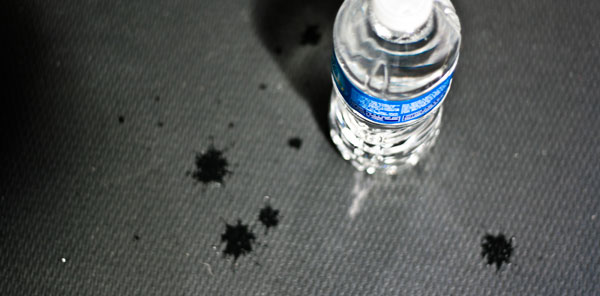
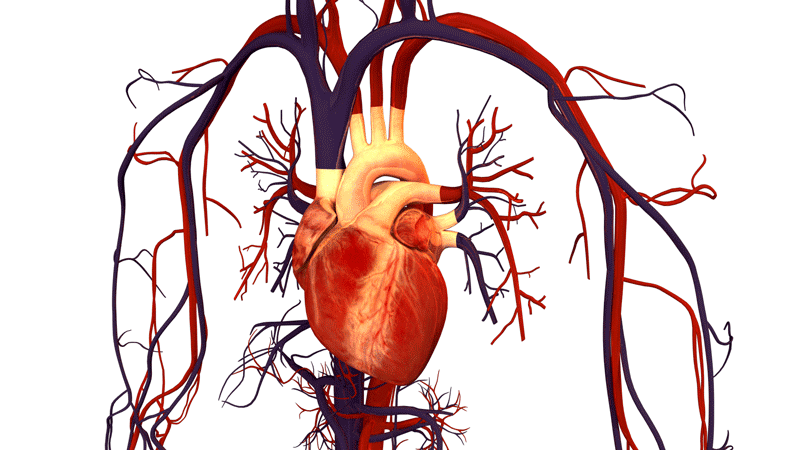


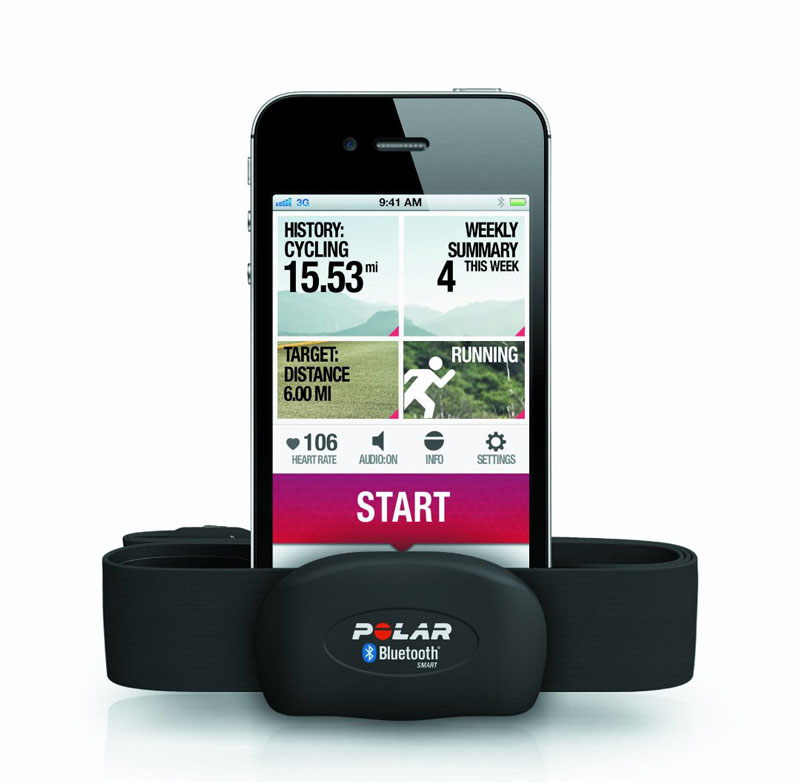

Add some color to this commentary.